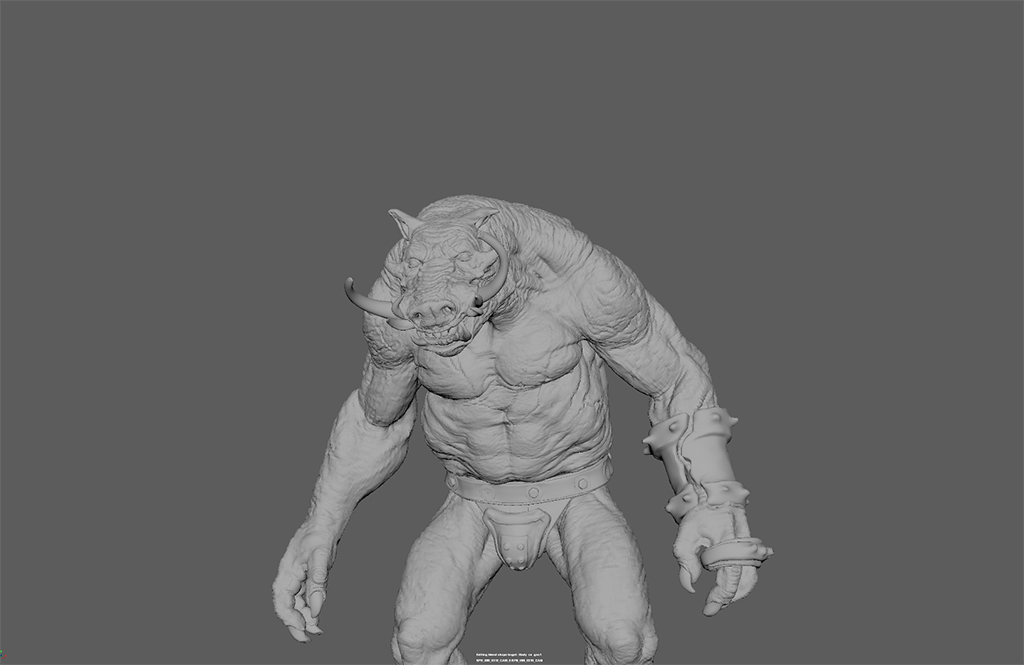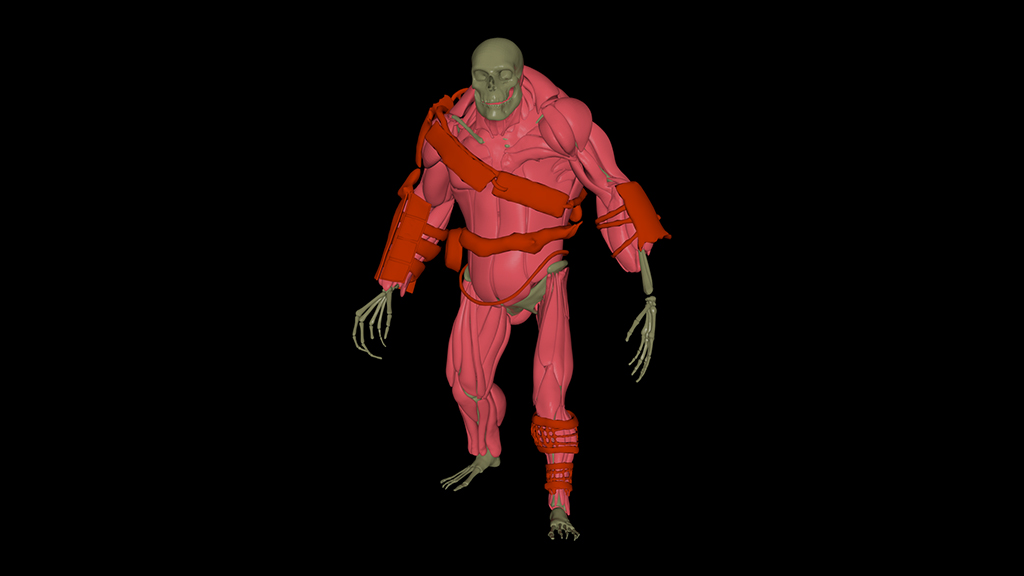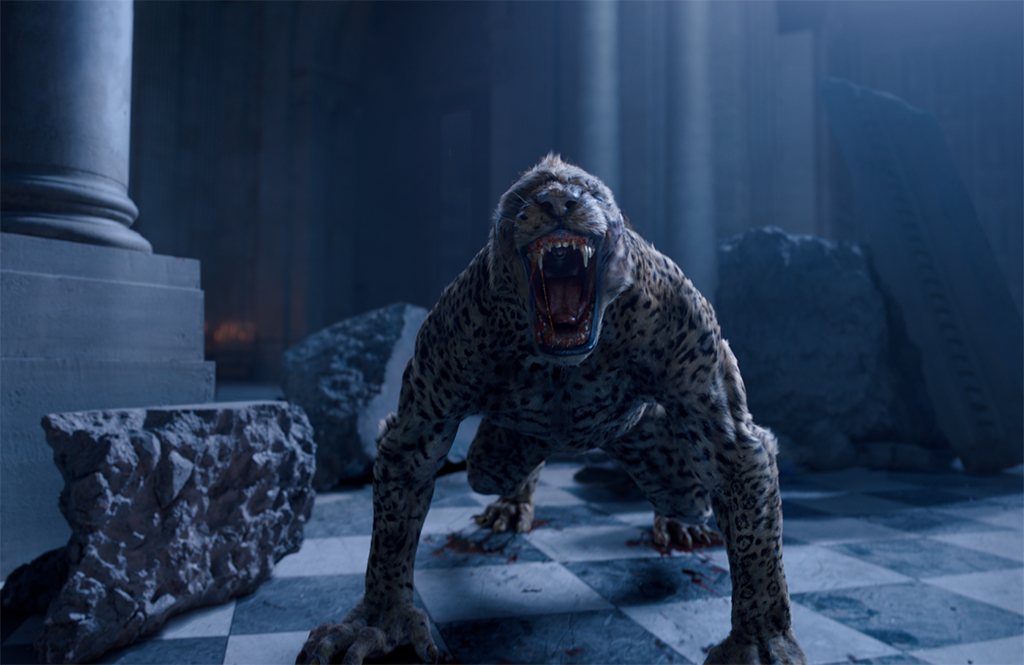By FABIO BONVICINI and ASHTON LOUIE
By FABIO BONVICINI and ASHTON LOUIE
This spring, the world-famous Hellboy series was rebooted and reimagined in Neil Marshall’s Hellboy (2019) from Lionsgate and Millennium, and with it, a new horde of dangerous, gigantic, and dynamic creatures – all dead-set on destroying mankind. Celebrating 25 years of multimedia success, the Hellboy franchise has a long history of character success. And now, in the golden era of supernatural cinematics, the need to achieve even more lifelike results was an inevitable new production challenge.
Technicolor’s VFX studio Mr. X won the bid to deliver five of the film’s key monsters, including a bipedal boar known as the ‘Gruagach,’ a gang of weapon-wielding giants, and a human/wild cat ‘werejaguar.’ The creature experts at Mr. X knew that flexible, scalable and fast character tools would be needed to successfully deliver such an array of monsters in such a short time. The team chose to use Ziva Dynamics soft-tissue and physics-simulation software, Ziva VFX, to bring the characters to life.
In this article, we discuss some of the unique challenges of each Hellboy character and discuss how the Mr. X team leveraged Ziva Dynamics technology to overcome each production obstacle.

The team kicked off their character work with the 2.5-meter-tall Gruagach. It took several months before the final Gruagach look was approved, but, ultimately, he took the form of a bipedal boar, with the physique of a human bodybuilder and the skin of a rhino. Mr. X built a full-body Ziva simulation, complete with an anatomical muscle system and a thick fat/skin layer, to bring the monster to life.

The Mr. X modeling and rigging teams worked closely to achieve a lifelike muscle system that captured the intensity of the Gruagach. We weren’t really phased by the numerous look changes. We were able to quickly update the geometry in the Ziva simulations and see results within hours. So, even though there were changes in the creative direction, we only needed one iteration of the Gruagach sim for the final render – everything else was just minor tweaks for greater accuracy.

The Gruagach’s fat and skin layers were then simulated in a single pass using the fat-wrapping tools released in Ziva VFX v1.4. This anatomy layer posed a unique challenge as it needed to be acutely thick, similar to that of a rhino hide, yet compatible with a fast moving, human sized body – an unnatural pairing. The team was able to manipulate the soft-tissue parameters in Ziva to tactfully increase the skin physics without compromising on other meaningful details, like sliding, mobility or muscle definition. Essentially, they achieved the desired result which was both unnatural in composition, yet completely natural looking.

Next on the chopping block were the 8-meter-tall giants who attack Hellboy in a major 3-on-1 fight scene. This destructive, ogre-esque species is notorious for their enormous size and adorning themselves in metals scraps and rags. For this reason, the complexity varied between the three giants significantly. The Axe Giant and Sword Giant are both wearing approximately 150 pieces of cloth that cover the majority of their big bodies. Meanwhile, the Club Giant is almost entirely nude and has the longest consecutive animation sequence of all five characters, with over 1,050 continuous frames. The Mr. X team chose to commit a full Ziva simulation process to hit the complex and anatomy-intense Club Giant shots. Conversely, they augmented a cloth-focused workflow with underlying Ziva sims for the two remaining giants.

Recreating the biomechanics of massive creatures is challenging, even for the most seasoned artists. Aware of this common obstacle, the Mr. X team strategically circumvented all the guesswork by using Ziva’s built-in anatomy scripts. These developer tools let the team quickly transfer the existing Gruagach muscles to fit the colossal Club Giant mesh. Although the Club Giant is over 3x the size of the Gruagach, the warping scripts effectively transferred the entire muscle system, along with the full simulation setup, including attachments, muscle commands, parameter settings, and more. We were grateful that we could scale up the tissues so easily and achieve a strong starting point for the giants so quickly. This scalable approach made it possible to complete the complex Club Giant rig in less than one week!

Individual fat/skin passes were then simmed for all three giants. The paintable Ziva Materials made it easy to make lifelike deformities on the giants. The large tumor on the top right shoulder of the Club Giant, for example, ended up having a Young’s Modulus of 21, which means that it has an elasticity/stiffness similar to gelatin and brain matter. Conversely, the rest of the monster’s fat/skin was 106, which is close to rubber. We really wanted the bulbous growths to look soft yet dense, so it couldn’t just hang like the rest of skin. Once we found the right material quantities, we plugged those in to Ziva’s material parameters and painted it on. It was really fast. Without Ziva, everything would have looked uniform and not nearly as realistic.
The final touches on the giants are their unique cloth and junkyard ornamentations. It’s critical that the weight of apparel, especially hard objects like armor, actively influence any soft tissue it comes in contact with. To replicate the effects of heavy chains and rope on the giants’ bodies, the Mr. X team simulated the hard objects as Ziva Bone objects and applied the Ziva IsoMesh functionality, so the articles would remain non-deforming while applying constant pressure to the underlying fat/skin.

The fifth and final simulated character for the Mr. X team was the human-turned-wild cat ‘werejaguar.’ The team primarily focused on the ominous mutation scene where audiences are first introduced to the werejaguar. In this shot, the character initially stood upright during his transformation, similar to the conventional werewolf form. However, as is tradition with most major motion pictures, the creative direction changed and, unexpectedly the team needed to adapt their biped to a quadruped to capture the beastly essence of the shot.
In a rush to the finish line, the Mr. X team opted to adapt the muscle rig from an existing were-creature that they had built for a previous blockbuster title. After updating the geometry, they simply turned the entire non-Ziva rig into a large group of Ziva Bone objects. Although this eliminated any anatomical muscle firing (since no muscles were actually used in the setup), the creature experts at Mr. X knew that this rapid approach would be compatible with the werejaguar’s permanently tense disposition in the scene.

The team then simulated a thin Ziva fat/skin pass, which would lie directly on top of the Ziva Bones. Once animated, the large bone layer naturally drove the custom dermal layer to produce the detailed secondary dynamics they needed. This unconventional use of Ziva Bones highlights the durability and versatility of the technology. This was the first time we ever turned a rig into one big bundle of bones, but we knew we needed to think outside of the box to hit the deadlines. We were very pleased with the result. The werejaguar looks strong and the skin looks very dynamic and stretchy, just the way you’d expect. It’s rare to find tools that let you have so much control while remaining faithful to the results.

A final cloth pass was then applied to add extra wrinkling effect to the werejaguar’s shoulder and neck area. This pass helped simulate the slinky, stretchy skin often seen on wild cats.
With that, the team at Mr. X brought to life all five Hellboy (2019) monsters.
Fabio Bonvicini is Creature CG Supervisor at Mr.X (mrxfx.com). Ashton Louie is a producer at Ziva Dynamics (zivadynamics.com).